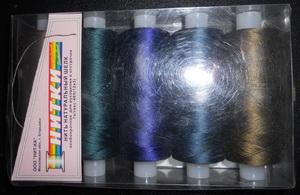Original text by Marina Belova
Every embroiderer ask himself or herself this question before beginning a new project: just how much threads will I need for it?
If you have a single-head embroidery machine, the answer is simple – you buy one or maybe two spools of each color, depending on the project size. Overall not too expensive. But when you need to buy threads for a multi-head embroidery machine, the price increases proportionately with the number of heads. Whereas the real thread expenditure for a whole batch of products is ludicrously small. You're lucky if the colors bought are in demand, and you'll be able to use them for your other projects.
Traditionally, the approximate amount of thread is calculated in the embroidery software. The process is very simple: open the file, read the design data and voila. The approximate upper thread to lower thread expenditure ratio is 3:1, at least, this what the embroidery software considers it to be.
I've never yet seen that thread expenditure estimated in an embroidery editor was correct. You always have to adjust it. I usually multiply it to 1.5–2.
There can be cases where it is impossible to open the file and to see the estimated thread expenditure. In a situation like this, you can turn to the manufacturers. Embroidery thread manufacturers also give you approximate algorithms for calculation.
For instance, Gunold suggests this formula for thread expenditure calculation: every 1000 stitches require about 5 m of the upper and 5 m of the lower (!) threads (1:1 ratio). This manufacturer also states that the higher the machine's speed, the more thread is used. Madeira equals every 1000 stitches to 3 m or the lower thread.
Gunold offers these thread expenditure figures in relation to the speed of the machine:
|
Embroidery machine speed, rpm |
|||
|
650 |
850 |
1000 |
|
|
Estimated upper thread expenditure |
1092 m |
1428 m |
1680 m |
|
Estimated lower thread expenditure |
765 m |
1000 m |
1175 m |
It is not clear what stitch length people making all these calculations had in mind. The longer is the stitch, the more thread it will take. Chances are that an average value of 3–4 mm was used as a basis. Besides, nobody in the real world takes into account the thread tension on every head of a particular machine. If the upper thread is loose, the expenditure will be higher. More than likely, the manufacturers made their calculations for an ideal situation: 2/3 of the upper and 1/3 of the lower threads. Unfortunately, there are no algorithms that include the fabric thickness for better precision.
Therefore, one should approach all those figures with caution. Trusting the figures given by a manufacturer used to lead me into traps. The real thread expenditure is much higher than the estimate. In all appearance, it's due to the reasons listed above.
For example, Madeira and Amann write that one spool containing 5 km of #40 threads is enough for 1 million stitches. Respectively, a spool containing 1 km of threads should be enough for ~200 thousand stitches.
In other words, Madeira and Amann suggest that it takes 4.6 m of the upper and 2.3 of the lower thread for every 1000 stitches. That is, the ratio here is 2:1.
There are great discrepancies, as you can see. But using even those unreliable figures is better than buying threads in a hit-and-miss fashion.
By the way, there is a website with an online calculator for those who are too lazy to calculate the thread expenditure themselves.



There are no reviews to display.